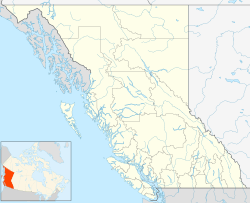Telegraph Creek facts for kids
Quick facts for kids
Telegraph Creek
|
|
|---|---|
| Country | Canada |
| Province | British Columbia |
| Regional district | Kitimat–Stikine |
| Area | |
| • Total | 1.46 km2 (0.56 sq mi) |
| Population
(2016)
|
|
| • Total | 53 |
| • Density | 36.3/km2 (94.0/sq mi) |
Telegraph Creek is a small town in northern British Columbia, Canada. It sits where the Stikine River meets Telegraph Creek. This is the only town along the Stikine River. About 250 people live here, including members of the Tahltan First Nation and other residents.
The town has basic services like churches, a general store, and a post office. There is also a health clinic with nurses and two Royal Canadian Mounted Police officers. Kids in Telegraph Creek go to a K-9 school. The area is known for its steep river banks and rocky canyons.
The Tahltan people, also called Nahanni, are a Northern Athabaskan group. They live in areas like Telegraph Creek, Dease Lake, and Iskut. The Tahltan First Nation and the Iskut First Nation together form the Tahltan Nation.
Contents
History of Telegraph Creek
The Stikine region has been the home of the Tahltan people for many generations. The modern history of Telegraph Creek began in the 1860s and 1870s. This was during the Stikine and Cassiar Gold Rushes.
Gold was found by prospectors on the Stikine River in the 1860s. Telegraph Creek became an important spot because boats could not go further up the river. In 1866, a telegraph line was being built to the Yukon. This project was called the Russian–American Telegraph. The town got its name from this telegraph line.
Long ago, about 10,000 years ago, the Tahltan people used a special rock called obsidian. They found this obsidian at the Mount Edziza volcanic complex. They used it to make tools and weapons. They also traded these items with other groups. This area was the main source of obsidian in northwestern British Columbia.
In 1874, a woman named Nellie Cashman opened a boarding house in Telegraph Creek. She was known as "the Angel of Cassiar." She helped miners during the Cassiar gold rush.
Fun Activities in Telegraph Creek
Telegraph Creek and the areas around it are great for outdoor fun. People enjoy hiking, boating on the river, camping, hunting, and fishing. You can find organized tours that last from a few hours to several days.
There are five British Columbia Provincial Parks close to Telegraph Creek:
- Stikine River Provincial Park
- Mount Edziza Provincial Park
- Great Glacier Provincial Park (about 100 km to the southwest)
- Choquette Hot Springs Provincial Park (southwest of Telegraph Creek)
- Border Lake Provincial Park (about 180 km to the south)
Getting to Telegraph Creek
The road from Dease Lake, BC, to Telegraph Creek is very scenic but also quite challenging. Most of the 113 km road is gravel. It has very steep hills, some as steep as 20%. The road can be narrow along canyon walls and has no guardrails in some spots. There are also sharp turns called switchbacks. Only the first 4.7 km of the road are paved.
The Telegraph Creek Road (also called Highway 51) needs careful driving. It is fine for most cars, but large RVs and travel trailers are not recommended. Sometimes, parts of the road can be closed due to washouts or rock slides. The government of BC shares warnings about road closures on its www.DriveBC.ca website.
You can also reach Telegraph Creek by boat on the Stikine River from Alaska. Another way to get there is by air.
Famous People from Telegraph Creek
- Dempsey Bob, a well-known carver.
- Dale Campbell, also a talented carver.


